
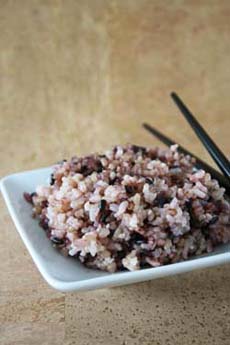
Multigrain rice: a blend of white and whole-grain rices. Photo by Hannah Kaminsky | THE NIBBLE
October 2007
Last Updated September 2023
|
 |
Rice: History & Types Of Rice
Page 5: Rice Glossary Terms L ~ R
This is Page 5 of a six-page article and glossary. Click on the black links below to visit other pages.
This material is copyrighted and cannot be reproduced in whole or in part
without written permission.
LIGHT BROWN RICE
In light brown rice, almost 50% of the bran is removed, whereas with brown rice, the bran layers are left intact. Brown rice is a whole grain, light brown rice is not, even though it is sometimes erroneously referred to as such. However, you will not find the Whole Grain Council’s whole grain stamp on any light brown rice product. Light brown rice was created to provide a faster cooking time—20 minutes instead of 45 minutes for regular brown rice—by polishing off the bran layers, the rice cooks more quickly. Also, some people don’t like the nutty flavor of brown rice but want an alternative to white rice. Light brown rice also has more fiber than white rice, although less than regular brown rice. The serving sizes are the same. See brown rice.
|
|
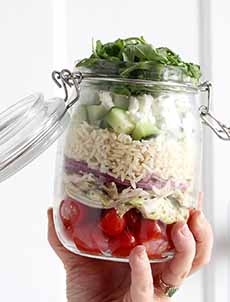
Light brown rice (photo © Della Rice).
|
LONG-GRAIN RICE or INDICA RICE
See grain types.
MEDIUM-GRAIN RICE
See grain types and japonica rice.
MINUTE RICE
See instant rice.
MOCHI RICE or SWEET RICE
Mochi is a specific variety of rice used for traditional Japanese and Korean rice cakes, mochi, sticky rice pudding, and other desserts and sweets. See glutinous rice.
MULTIGRAIN RICE
A blend of rices that mixes different grains to create a more complex flavor. See the photo at the top of the page.
PAELLA RICE
See Bomba rice and Calasparra rice.
PEARL RICE
See glutinous rice.
|
|
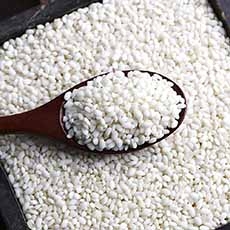
Mochi rice (photo © Rom America). |
POHA or PRESSED RICE or FLATTENED RICE
An Indian specialty. The rice grain is pressed to make rice flakes, just as corn is pressed into corn flakes. Before pressing, the rice grains have to be soaked in water for eight hours; then the wet grains are roasted. When roasted, the outer layer of the rice grains becomes brittle while the grain becomes soft, such that when the grains are put into the pressing machine, the outer layer is crushed, and the grain is pressed flat into flakes. Pressed rice is popularly mixed with cooked potatoes and garnished with lime juice, grated coconut, and chopped coriander.
|
|
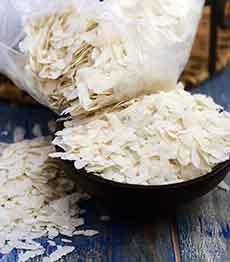
Poha rice (photo © Tarla Dadal).
|
POLOW RICE
See shahi rice.
POPCORN RICE
Popcorn rice is gourmet rice grown in Louisiana. It is said to have the flavor of fresh popcorn while it cooks. We didn’t lift the lid to sniff (because the steam needs to stay sealed inside to cook the rice), and we’ve only had one brand of popcorn rice. It smelled like basmati rice, which it resembled. It is delicious rice, but the “popcorn” aspect is more of a marketing device than an actual flavor and aroma feature.
|
|
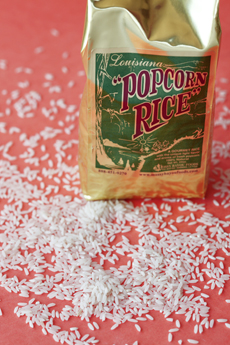
Popcorn rice. Photo by Katharine Pollak | THE NIBBLE. |
PUFFED RICE
Puffed rice is usually made by heating rice kernels under high pressure in the presence of steam, though the method of manufacture can vary. In the U.S., puffed rice is a popular breakfast cereal, but in other parts of the world, it is a street food, like popcorn. In India, it is the rice version of popcorn. it is also used in recipes.
|
|
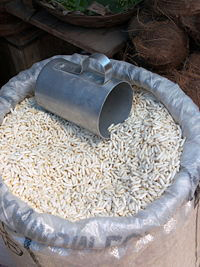
Indian puffed rice. Photo courtesy of Wikipedia.org. |
RED RICE
Red rice is an unhulled or partially hulled rice that has a red husk (most rice has a brown husk). As an unhulled rice, red rice has a nutty flavor and high nutritional value from the germ. See Bhutanese red rice.
REGULAR-MILLED WHITE RICE
See white rice.
|
|
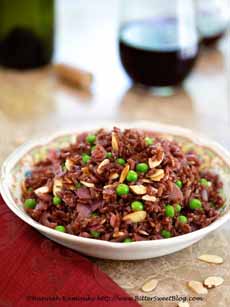
Red rice in a pilaf (photo © Hannah Kaminsky | Bittersweet Blog).
|
RICE
Rice is a type of grass, like barley, millet, rye, or wheat; its seeds, or grains, are eaten, and are a source of carbohydrate.
Rice grows wild in Southeast Asia. The staple grain of two-thirds of the world’s population, rice is a grass that originated in southeast Asia and Africa.
Rice is a member of the botanical family Poaceae, genus Oryza. Oryza sativa, the genus of the majority of our table rice, appears to have been domesticated from wild Asian rice around the foothills of the Himalayas.
There are three basic varieties from which all others descend: short-grained “japonica” or “sinica” varieties (Japanese rice), the long-grained “indica” varieties (basmati rice), and the broad-grained “javonica” varieties.
O. glaberrima comprises the native African rices, which are being replaced in Africa by the introduction of the preferred Asian species.
See descriptions in this glossary for individual cultivars of rice: Arborio, basmati, Bhutanese red rice, black forbidden, black japonica, calrose, carnaroli, glutinous, jasmine, kalijira, koshihikari, poha, shahi, vialone nano, and others. There are also stylistic types of rice, such as aromatic, brown, converted, glutinous, instant, and white.
Regardless of the variety, adding some whole spices, nuts, dried fruits, vegetables, beans, and/or meats or seafood to a bowl of rice turns it into a main meal.
|
|
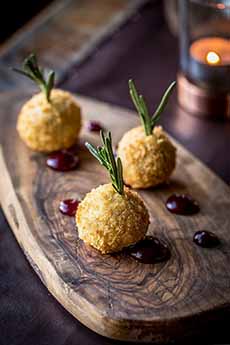 Arancini are Italian rice balls that are stuffed, coated with breadcrumbs, and deep-fried. They are a staple of Sicilian cuisine (photo © Gordon Ramsay Group). Arancini are Italian rice balls that are stuffed, coated with breadcrumbs, and deep-fried. They are a staple of Sicilian cuisine (photo © Gordon Ramsay Group).
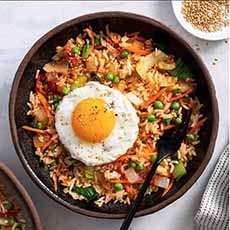
Kimchi fried rice topped with a fried egg: a Japanese-Korean fusion food. Here’s a recipe (photo © Sun Basket).
|
RISOTTO
A creamy rice dish, an Italian specialty. Labor-intensive, risotto is made by stirring hot stock into arborio rice that has been sautéed in butter; chopped onions are often part of the recipe. The stock is added a half cup at a time and the mixture is stirred continually until all the liquid is absorbed before more stock is added. The wide, short arborio rice grains remain separate and firm. There are many different risotto recipes, from vegetarian varieties that use only Parmigiano-Reggiano cheese and/or vegetables, to chicken, sausage, and seafood. Herbs are sometimes the focus: The famous risotto Milanese is scented with saffron.
|
|
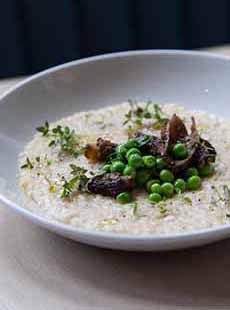 Wild mushroom and spring pea risotto (photo © Café Clover | NYC [now closed]). Wild mushroom and spring pea risotto (photo © Café Clover | NYC [now closed]). |
Continue To Next Page: Terms S ~ Z
Go To Article Index Above

|
 |










 Arancini are Italian rice balls that are stuffed, coated with breadcrumbs, and deep-fried. They are a staple of Sicilian cuisine (photo ©
Arancini are Italian rice balls that are stuffed, coated with breadcrumbs, and deep-fried. They are a staple of Sicilian cuisine (photo © 
